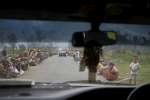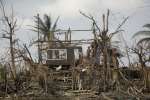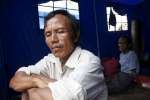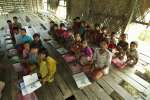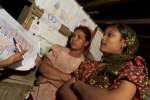Myanmar relocates thousands of displaced people ahead of Cyclone Mahasen
News Stories, 16 May 2013
YANGON, Myanmar, May 16 (UNHCR) – As Cyclone Mahasen approaches the coasts of Myanmar and Bangladesh, more than 35,000 internally displaced people in Myanmar's Rakhine state have been moved to safer locations under a government evacuation plan. Many more have moved spontaneously into local communities to avoid the brunt of the storm, which is expected to hit land on Thursday night.
Rakhine state is home to up to 140,000 people who were displaced in inter-communal violence last year. The UN estimates that some 70,000 of them in and around Sittwe, Pauktaw and Myebon are especially vulnerable to the cyclone's impact as they are encamped near the coast, in low-lying areas or in flimsy makeshift shelters.
Emergency evacuation started on Monday, led by the Rakhine state government. More than 35,000 displaced people had been moved to public buildings, temporary shelters or higher ground by Wednesday. The relocations continued into Thursday amid heavy rains and strong winds.
"The authorities have assured us that everyone at risk will be relocated and assisted without discrimination," said Hans ten Feld, UNHCR's representative in Myanmar. "UNHCR and other agencies have been monitoring the process to ensure that there is consultation, that vulnerable individuals are prioritized, that families are not separated in the process, that rights are respected."
UNHCR teams on the ground are also helping to ease the concerns of some IDPs who refuse to move to government-designated relocation sites. In rural Sittwe, displaced people in Hmanzi Junction decided on Thursday that they wanted to move after all, prompting aid workers to seek trucks to transport them to nearby schools. The authorities have given verbal assurances that they will be able to return to Hmanzi Junction after the storm passes.
Another group of 7,000 displaced people in Nget Chaung in Pauktaw township declined to move to a government site and preferred to move elsewhere by boat. After a tragic accident on Monday night in which more than 50 people are still missing, the authorities started providing boats and escorts to the group's alternative location. This continued until the waters became too rough to navigate. The remaining 1,000 people are now moving to a nearby mosque, which risks overcrowding.
UNHCR has deployed a senior shelter coordinator to help assess the relocation sites. Together with other experts, he is advising the government on whether the shelters, facilities and services are adequate for the large numbers of evacuees.
"The government and humanitarian community are pulling all the stops to relocate as many people as possible before the storm," said ten Feld. "With the storm expected later today, we will need to shift the focus quickly to relief and recovery work."
UNHCR has mobilized its stocks of tents, plastic sheets and other relief items to support any post-cyclone needs among the displaced population in Rakhine state.
Meanwhile, the Bangladesh government has ordered the evacuation of 1 million people from townships that are at risk in the south. There are an estimated 230,000 people of concern to UNHCR in that area, including 30,000 Rohingya refugees in two camps, and more than 200,000 undocumented Rohingya from Rakhine state. UNHCR has made preparations in the refugee camps, identifying buildings that can serve as shelters and pre-positioning relief supplies. The government has given assurances that assistance will be provided to all cyclone-affected people without discrimination.





